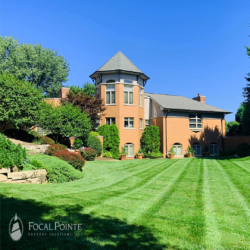As the cooler evenings of Fall arrive, we can sometimes be tricked into believing that the need to focus on landscaping ends with the long warm days of summer. Spring is often thought of as the beginning of the growing season. However, the cool-turfgrass season begins in early September. What we do during the Fall actually has a greater impact on our lawns next year, than what we do in the Spring. Fall provides an important opportunity to rejuvenate turf, after hot and often dry summer months that are the most stressful for fescue, bluegrass, and rye grasses. It is the beginning of a year-long program designed to make thick deep-green, weed-free lawns.

- Fall Treatments:Soil modification including aeration and adding organic material, loosens the soil allowing air, water, and fertilizers to penetrate and build great roots. Fall fertilizer is formulated to stimulate roots, and applications of broadleaf herbicides eliminate cool-season weeds that become unsightly in Spring. Fully over-seeding with newer varieties produce new plants with improved traits to develop thick, healthy carpets of turf.
- Early-Spring Treatments: While temperatures are too low for seed germination, apply crabgrass preemergent to keep one of the lawn’s hardiest invaders from getting a foothold. Fertilization should include a slow-release broad-spectrum formula, so plants have access to nutrients for weeks.
- Late-Spring Treatments: As grasses emerge from dormancy when soil temperatures rise, fertilize for continued root development and deep green color. Late spring is also the time for another broadleaf herbicide application to rid turf of new broadleaf weeds.
- Early-Summer Treatments: Continue to add nutrients with slow-release fertilizer and if necessary apply a targeted insecticide to eliminate surface feeding insects and/or grubs under the turf that damage the plants.
- Mid-Summer Treatments: Use great care when applying fertilizer now, as grasses may already be stressed due to heat and low moisture. Organic slow-release fertilizers cause less damage to stressed turf than chemical formulations. This is also a great time to add iron for deep green color without stressing the turf with high-nitrogen alternatives. Iron applications are particularly effective with fescue and bluegrass varieties.
Follow a seasonal program like the one outlined above, and you’ll find one of the most important elements of your landscape looking better than ever. Apply fertilizer, pest, or weed control products only at the recommended rate. The best weed control and most effective way to reduce the use of pesticides for that matter is healthy turf driven by healthy cultural habits. Good soil, proper mowing height, proper watering, and timely use of high-quality products is the recipe for creating beautiful thick lawns throughout the year. A great-looking, healthy lawn adds value to your property, the environment, and quality of life.
